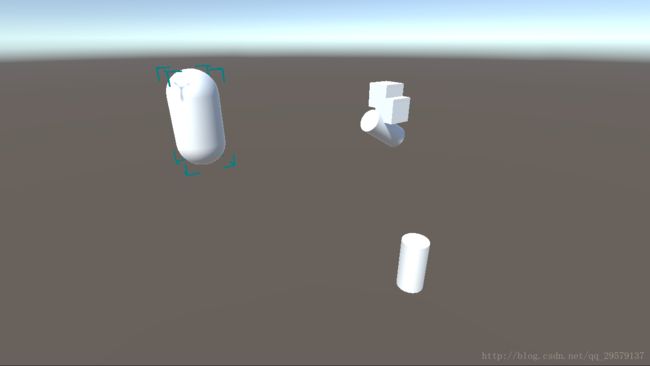Untiy网格编程篇(一)包围盒效果
Untiy网格编程篇(一)包围盒效果(纯代码,网格实现)
==转载标明出处==
1.效果图:
选中不同的模型,会标识出包围盒的效果
2.实现思路:
第一步:计算模型的AABB包围盒;
第二步:利用包围盒尺寸,获取包围盒的八个顶点,然后对每个顶点三个方向延长线上的顶点,绘制时可以绘制面,但是绘制柱体效果更好,本文为绘制柱体
第三步:设置网格顶点和网格的三角面
第四步:得到上图的效果
3.代码部分:
using UnityEngine;
using System.Collections.Generic;
namespace MeshTools
{
//利用RequireComponent特性,添加实现效果所需要的组件
[RequireComponent(typeof(MeshFilter),typeof(MeshRenderer))]
public class BoundEffect : Monobehaviour
{
private Mesh _mesh = null;
private MeshFilter _meshFilter = null;
private flaot _lineLenght = 0.25f; //线条长度
private float _lineWidth = 0.025f; //线条宽度
private Bounds _bounds ; //要模拟的包围盒
private Vector3 _boundsPosition; //包围盒的实际位置
//这里是需要添加包围盒特表的模型
private Transform _target = null;
public Transform Target
{
get { return _target;}
set
{
if (value == _target) return;
_target = value;
// 这里需要计算组合模型的包围盒 可以参照我的另一篇博客Bounds(包围盒)概述与AABB包围盒应用
//http://blog.csdn.net/qq_29579137/article/details/70502591
//里面有关于BOUNDS()的拓展方法的详细代码与其他使用方式
//_bounds = value.BOUNDS();
_bounds = value.GetComponent().bounds;
_boundsPosition = value.position;
Refresh();
}
}
//初始化组件信息
private void Start()
{
_meshFilter = this.GetComponent();
_mesh = new Mesh { name = "BoundEffect" };
_meshFilter.mesh = _mesh;
}
///
/// 包围盒大小,以及包围盒位置
///
///
///
public void SetEffect( Bounds bounds ,Vector3 boundsPosition )
{
_bounds = bounds;
_boundsPosition = boundsPosition;
Refresh();
}
//绘制网格的方法
private void Refresh()
{
//初始化包围盒位置
InitPosition();
//获取包围盒的八个顶点,按续存储到List
List vertexList = new List();
Vector3 unit = _bounds.extents;
float xLenght = unit.x;
float yLenght = unit.y;
float zLenght = unit.z;
vertexList.Add(new Vector3(xLenght , yLenght , zLenght));
vertexList.Add(new Vector3(xLenght , yLenght , -zLenght));
vertexList.Add(new Vector3(xLenght , -yLenght , zLenght));
vertexList.Add(new Vector3(xLenght , -yLenght , -zLenght));
vertexList.Add(new Vector3(-xLenght , yLenght , zLenght));
vertexList.Add(new Vector3(-xLenght , yLenght , -zLenght));
vertexList.Add(new Vector3(-xLenght , -yLenght , zLenght));
vertexList.Add(new Vector3(-xLenght , -yLenght , -zLenght));
//计算每个顶点向其他三个方向延伸的三个顶点,并将它们记录到字典中
Dictionary> children = new Dictionary>();
for ( int i = 0 ; i < vertexList.Count ; i++ )
{
Vector3 vertex = vertexList[i];
//计算延伸的顶点
List childVertexs = new List
{
vertex + new Vector3(-vertex.x/Mathf.Abs(vertex.x) * _lineLenght, 0, 0),
vertex + new Vector3(0, -vertex.y/Mathf.Abs(vertex.y) * _lineLenght, 0),
vertex + new Vector3(0, 0, -vertex.z/Mathf.Abs(vertex.z) * _lineLenght)
};
children.Add(i , childVertexs);
}
// 初始化网格数据,计算每个角上三个长方体八个顶点的位置,并加入vertexs中
List vertexs = new List();
//三角面数量的计算 每个长方体12个三角面,36个三角面的点,一共 8*3*36
int[] triangle = new int[8 * 3 * 36];
//根据线条宽度换算成半径数值
float lineUnit = _lineWidth / 2.0f;
for ( int i = 0 ; i < children.Count ; i++ )
{
Vector3 center = vertexList[i];
List childs = children[i];
//按序号取出延伸点进行长方体顶点的计算
for ( int j = 0 ; j < childs.Count ; j++ )
{
if ( j.Equals(0) )
vertexs.AddRange(getVertexsBy2Point(center + new Vector3(center.x / Mathf.Abs(center.x) * lineUnit , 0 , 0) , childs[j] , "X"));
if ( j.Equals(1) )
vertexs.AddRange(getVertexsBy2Point(center + new Vector3(0 , center.y / Mathf.Abs(center.y) * lineUnit , 0) , childs[j] , "Y"));
if ( j.Equals(2) )
vertexs.AddRange(getVertexsBy2Point(center + new Vector3(0 , 0 , center.z / Mathf.Abs(center.z) * lineUnit) , childs[j] , "Z"));
}
}
// 设置三角面顶点序号 分为六个面,共十二个三角面分别赋值
// 详细原理可以去了解三角面的渲染原理
for ( int i = 0, count = 0 ; count < triangle.Length ; i += 8, count += 36 )
{
triangle[count + 0] = i + 0;
triangle[count + 1] = i + 2;
triangle[count + 2] = i + 1;
triangle[count + 3] = i + 0;
triangle[count + 4] = i + 3;
triangle[count + 5] = i + 2;
triangle[count + 6] = i + 4;
triangle[count + 7] = i + 5;
triangle[count + 8] = i + 7;
triangle[count + 9] = i + 5;
triangle[count + 10] = i + 6;
triangle[count + 11] = i + 7;
triangle[count + 12] = i + 0;
triangle[count + 13] = i + 1;
triangle[count + 14] = i + 5;
triangle[count + 15] = i + 0;
triangle[count + 16] = i + 5;
triangle[count + 17] = i + 4;
triangle[count + 18] = i + 1;
triangle[count + 19] = i + 2;
triangle[count + 20] = i + 6;
triangle[count + 21] = i + 1;
triangle[count + 22] = i + 6;
triangle[count + 23] = i + 5;
triangle[count + 24] = i + 2;
triangle[count + 25] = i + 3;
triangle[count + 26] = i + 7;
triangle[count + 27] = i + 2;
triangle[count + 28] = i + 7;
triangle[count + 29] = i + 6;
triangle[count + 30] = i + 3;
triangle[count + 31] = i + 0;
triangle[count + 32] = i + 4;
triangle[count + 33] = i + 3;
triangle[count + 34] = i + 4;
triangle[count + 35] = i + 7;
}
// 最后设置网格的顶点和三角面
_mesh.vertices = vertexs.ToArray();
_mesh.triangles = triangle;
}
//初始化包围盒位置
private void InitPosition()
{
transform.position = _boundsPotision + _bounds.center;
}
//通过两点计算出长方体的八个顶点
private List getVertexsBy2Point( Vector3 first ,Vector3 second , string axis )
{
List vertexs = new List();
float lineUnit = _lineWidth / 2.0f;
switch (axis)
{
case "X":
vertexs.Add(first + new Vector3(0 , lineUnit , lineUnit));
vertexs.Add(first + new Vector3(0 , lineUnit , -lineUnit));
vertexs.Add(first + new Vector3(0 , -lineUnit , -lineUnit));
vertexs.Add(first + new Vector3(0 , -lineUnit , lineUnit));
vertexs.Add(second + new Vector3(0 , lineUnit , lineUnit));
vertexs.Add(second + new Vector3(0 , lineUnit , -lineUnit));
vertexs.Add(second + new Vector3(0 , -lineUnit , -lineUnit));
vertexs.Add(second + new Vector3(0 , -lineUnit , lineUnit));
return vertexs;
case "Y":
vertexs.Add(first + new Vector3(lineUnit , 0 , lineUnit));
vertexs.Add(first + new Vector3(lineUnit , 0 , -lineUnit));
vertexs.Add(first + new Vector3(-lineUnit , 0 , -lineUnit));
vertexs.Add(first + new Vector3(-lineUnit , 0 , lineUnit));
vertexs.Add(second + new Vector3(lineUnit , 0 , lineUnit));
vertexs.Add(second + new Vector3(lineUnit , 0 , -lineUnit));
vertexs.Add(second + new Vector3(-lineUnit , 0 , -lineUnit));
vertexs.Add(second + new Vector3(-lineUnit , 0 , lineUnit));
return vertexs;
case "Z":
vertexs.Add(first + new Vector3(lineUnit , lineUnit , 0));
vertexs.Add(first + new Vector3(lineUnit , -lineUnit , 0));
vertexs.Add(first + new Vector3(-lineUnit , -lineUnit , 0));
vertexs.Add(first + new Vector3(-lineUnit , lineUnit , 0));
vertexs.Add(second + new Vector3(lineUnit , lineUnit , 0));
vertexs.Add(second + new Vector3(lineUnit , -lineUnit , 0));
vertexs.Add(second + new Vector3(-lineUnit , -lineUnit , 0));
vertexs.Add(second + new Vector3(-lineUnit , lineUnit , 0));
return vertexs;
default:
return vertexs;
}
}
}
}
4.总结:
1.以上提供两种设置效果的方法,直接赋值Target 或者 调用SetEffect();
2.包围盒的效果可根据线条的长度和宽度进行设置,也可以动态的根据包围盒的比例进行计算设置获取更好的显示效果;包围盒计算可以参照我的另一篇博客http://blog.csdn.net/qq_29579137/article/details/70502591
3.在添加了MeshRenderer的组件之后,要为MeshRenderer添加材质(新建一个材质球赋值即可),并且可以设置材质球的颜色来确定包围盒效果的颜色;
4.设置Mesh时没有设置uv值和法线值,是因为不设置看起来融合的更加统一,设置了就会以长方体的样式渲染,存在面重合等多种问题;
5.组合模型要实现以上效果需要动过代码计算组合模型,关于组合模型的包围盒计算,在以后的文章中进行讲述。
==代码可以直接运行==
==转载标明出处==


